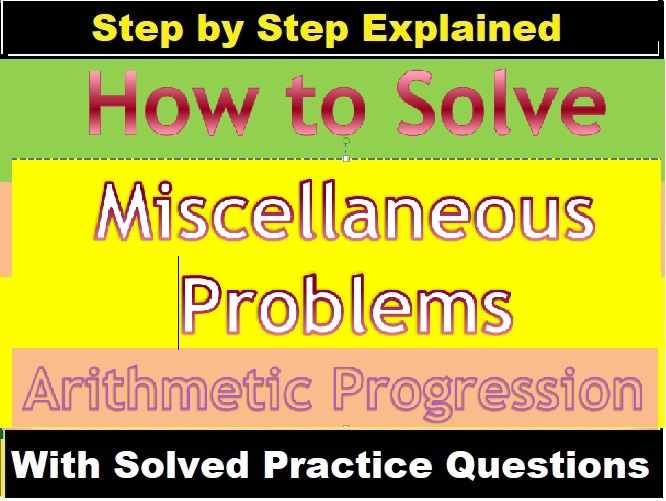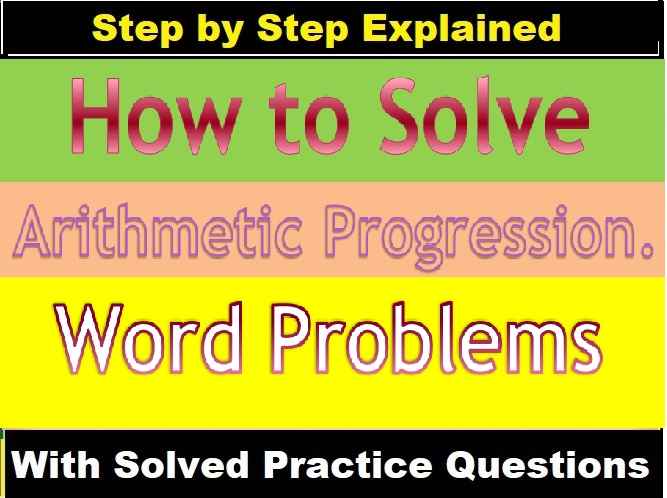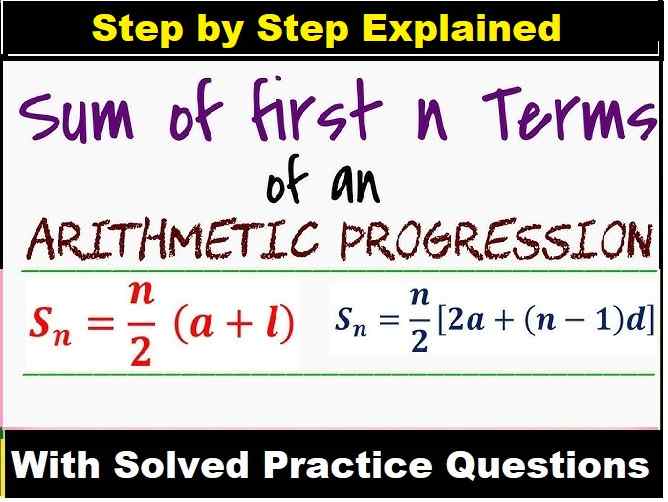Arithmetic Progression Exe-10F Class-10 Concise ICSE Maths Solution Ch-10. In this article you would learn solving miscellaneous problems on A.P. We Provide Step by Step Solutions / Answer of questions for Selina Concise Maths. Visit official Website CISCE for detail information about ICSE Board Class-10 Mathematics.

Arithmetic Progression Exe-10F Class-10 Concise ICSE Maths Solution Ch-10
| Board | ICSE |
| Publications | Selina |
| Subject | Maths |
| Class | 10th |
| Chapter-10 | Arithmetic Progression |
| Writer | R.K. Bansal |
| Exe-10E | Miscellaneous Problems on A.P. |
| Edition | 2025-2026 |
Miscellaneous Problems on A.P.
Arithmetic Progression Exe-10F Class-10 Concise ICSE Maths Solution Ch-10
Que-1: The 6th term of an A.P. is 16 and the 14th term is 32. Determine the 36th term.
Ans: Let the first term and common difference of an A.P. be a and d
Now, t6 = 16 …(Given)
a + 5d = 16 …(i)
And t14 = 32 …(Given)
a + 13d = 32 …(ii)
Subtracting (i) from (ii), we get
8d = 16
d = 2
a + 5(2) = 16
a = 6
Hence, 36th term = t36
= a + 35d
= 6 + 35(2) = 76
Que-2: If the third and the 9th terms of an A.P. term is 12 and the last term is 106. Find the 29th term of the A.P.
Ans: For an A.P., a
t3 = 4
a + 2d = 4 …(i)
t9 = – 8
a + 8d = – 8 …(ii)
Subtracting (i) from (ii), we get
6d = –12
d = –2
Substituting d = –2 in (i), we get
a + 2(–2) = 4
a – 4 = 4
a = 8
General term = tn = 8 + (n – 1)(–2)
Let pth term of this A.P. be 0
8 + (p – 1) × (–2) = 0
8 – 2p + 2 = o
10 – 2p = 0
2p = 10
p = 5
Thus, 5th term of this A.P. is 0
Que-3: An A.P. consists of 50 terms of which 3rd term is 12 and the last term is 106. Find the 29th term of the A.P.
Ans: a3 = 12
a50 = 106
We know that,
an = a + (n − 1)d
a3 = a + (3 − 1)d
12 = a + 2d …(i)
Similarly, a50 = a + (50 − 1)d
106 = a + 49d …(ii)
On subtracting (i) from (ii), we obtain
94 = 47d
d = 2
From equation (i), we obtain
12 = a + 2(2)
a = 12 − 4
a = 8
a29 = a + (29 − 1)d
a29 = 8 + (28)2
a29 = 8 + 56
a29 = 64
Que-4: Find the arithmetic mean of :
(i) – 5 and 41
(ii) 3x – 2y and 3x + 2y
(iii) (m + n)² and (m – n)²
Ans: (i)
Arithmetic mean between – 5 and 41
= -5+41/2
= 36/2 = 18
(ii)
Arithmetic mean of (3x – 2y) and (3x + 2y)
= 3x-2y+3x+2y2
= 6×2
= 3x
(iii)
Arithmetic mean of (m + n)2 and (m – n)2
= (m+n)2+(m-n)2/ 2
= m2+n2+2mn+m2+n2-2mn / 2
=2(m2+n2)/2
= m2 + n2
Que-5: Find the sum of first 10 terms of the A.P. 4 + 6 + 8 +…..
Ans: First term, a = 4
Common difference, d = 6 – 4 = 2
n = 10
S=n/2[2a+(n-1)d]
= 10/2[2(4)+9(2)]
= 5[8 + 18]
= 5 × 26
= 130
Que-6: Find the sum of first 20 terms of an A.P. whose first term is 3 and the last term is 60.
Ans: First term, a = 3
Last term, l = 57
n = 20
S=n/2(a+I)
= 20/2(3+57)
= 10 × 60 = 600
Que-7: How many terms of the series 18 + 15 + 12 +…..when added together will give 45 ?
Ans: A.P. is 18 + 15 + 12 +…..
Here, a = 18, d = 15 – 18 = – 3
Thus, the given series is an A.P. with first term 18 and common difference –3.
Let the number of terms to be added be ‘n’.
Sn=n2[2a+(n-1)d]
45=n2[2(18)+(n-1)(-3)]
90 = n[36 – 3n + 3]
90 = n[39 – 3n]
90 = 3n[13 – n]
30 = 13n – n2
n2 – 13n + 30 = 0
n2 – 10n – 3n + 30 = 0
n(n – 10) – 3(n – 10) = 0
(n – 10)(n – 3) = 0
n – 10 = 0 or n – 3 = 0
n = 10 or n = 3
Thus, the required number of terms to be added is 3 or 10
Que-8: The nth term of a sequence is 8 – 5n. Show that the sequence is an A.P.
Ans: tn = 8 – 5n
Replacing n by (n + 1), we get
tn+1 = 8 – 5(n + 1)
= 8 – 5n – 5
= 3 – 5n
Now,
tn+1 – tn = (3 – 5n) – (8 – 5n) = –5
Since, (tn+1 – tn) is independent of n and is therefore a constant.
Hence, the given sequence is an AP
Que-9: The the general term (nth term) and 23rd term of the sequence 3, 1, – 1, – 3,……
Ans: The given sequence is 1, –1, –3, ………..
Now,
1 – 3 = –1 – 1
= –3 – (–1)
= –2
Hence, the given sequence is an A.P. with first term a = 3 and common difference d = –2.
The general term (nth term) of an A.P. is given by
tn = a + (n – 1)d
= 3 + (n – 1)(–2)
= 3 – 2n + 2
= 5 – 2n
Hence, 23rd term = t23
= 5 – 2(23)
= 5 – 46 = –41
Que-10: Which term of the sequence 3, 8, 13,…..is 78 ?
Ans: The given sequence is 3, 8, 13, ……..
Now,
8 – 3 = 13 – 8 = 5
Hence, the given sequence is an A.P. with first term a = 3 and common difference d = 5.
Let the nth term of the given A.P. be 78.
78 = 3 + (n – 1)(5)
75 = 5n – 5
5n = 80
n = 16
Thus, the 16th term of the given sequence is 78
Que-11: Is – 150 a term of 11, 8, 5, 2,….. ?
Ans: The given sequence is 11, 8, 5, 2, …….
Now,
8 – 11 = 5 – 8
= 2 – 5
= –3
Hence, the given sequence is an A.P. with first term a = 11 and common difference d = –3.
The general term of an A.P. is given by
tn = a + (n – 1)d
–150 = 11 + (n – 1)(–3)
–161 = –3n + (–3)
3n = 164
n=164/3
The number of terms cannot be a fraction.
So, clearly, –150 is not a term of the given sequence.
Que-12: How many two digit numbers are divisible by 3 ?
Ans: The two digit numbers divisible by 3 are as follows:
12,15,18,21,…………,99
Clearly, this forms an A.P with first term, a = 12
and common difference, d = 3
Last term = nth term = 99
The general term of an A.P is given by
tn = a + (n – 1)d
99 = 12 + (n – 1)(3)
99 = 12 + 3n – 3
90 = 3n
n = 30
Thus, 30 two digit numbers are divisible by 3
Que-13: How many multiples of 4 lie between 10 and 250 ?
Ans: Numbers between 10 and 250 which are multiple of 4 are as follows:
12, 16, 20, 24, ………, 248
Clearly this forms an A.P. with first term a = 12,
Common difference d = 4 and last term I = 248
248 = 12 + (n – 1)(4)
248 = 12 + 4n – 4
248 = 4n + 8
4n = 248 – 8
4n = 240
n = 240/4
n = 60
Thus, 60 multiples of 4 lie between 10 and 250
Que-14: The sum of the 4th term and the 8th term of an A.P. is 24 and the sum of 6th term and the 10th term is 44. Find the first three terms of the A.P.
Ans: Given
t4 + t8 = 24
(a + 3d) + (a + 7d) = 24
2a + 10d = 24
a + 5d = 12 …(i)
And,
t6 + t10 = 44
(a + 5d) + (a + 9d) = 44
2a + 14d = 44
a + 7d = 22 …(ii)
Subtracting (i) from (ii), we get
2d = 10
d = 5
Substituting value of d in (i), we get
a + 5 × 5 = 12
a + 25 = 12
a = -13 = 1st term
a + d = -13 + 5 = -8 = 2nd term
a + 2d = -13 + 2 × 5 = -13 + 10 = -3 = 3rd term
Hence, the first three terms of an A.P are -13, -8 and -3.
Que-15: The sum of first 14 terms of an A.P. is 1050 and its 14th term is 140. Find the 20th term.
Ans:
Let ‘a’ be the first term and ‘d’ be the common difference of the given A.P.
Given,
S14 = 1050
14/2[2a+(14-1)d]=1050
7[2a + 13d] = 1050
2a + 13d = 150
a + 6.5d = 75 …(i)
And t14 = 140
a + 13d = 140 …(ii)
Subtracting (i) from (ii), we get
6.5d = 65
d = 10
a + 13(10) = 140
a = 10
Thus, 20th term = t20
= 10 + 19d
= 10 + 19(10) = 200
Que-16: The 25th term of an A.P. exceeds its 9th term by 16. Find its common difference.
Ans: nth term of an A.P. is given by tn= a + (n – 1) d.
t25 = a + (25 – 1)d = a + 24d and
t9 = a + (9 – 1)d = a + 8d
According to the condition in the question, we get
t25 = t9 + 16
a + 24d = a + 8d + 16
and ⇒ 16d = 16
Hence ⇒ d = 1
Que-17: For an A.P., show that:
(m + n)th term + (m – n)th term = 2 × mth term
Ans: Let a and d be the first term and common difference respectively.
(m + n)th term = a + (m + n – 1)d …. (i) and
(m – n)th term = a + (m – n – 1)d …. (ii)
From (i) + (ii), we get
(m + n)th term + (m – n)th term
= a + (m + n – 1)d + a + (m – n – 1)d
and = a + md + nd – d + a + md – nd – d
= 2a + 2md – 2d
so = 2a + (m – 1)2d
Hence = 2[ a + (m – 1)d]
= 2 × mth term
Hence proved.
Que-18: If the nth term of the A.P. 58, 60, 62,…. is equal to the nth term of the A.P. -2, 5, 12, …., find the value of n.
Ans: In the first A.P. 58, 60, 62,….
a = 58 and d = 2
tn = a + (n – 1)d
⇒ tn = 58 + (n – 1)2 …. (i)
In the first A.P. -2, 5, 12, ….
a = -2 and d = 7
tn = a + (n – 1)d
⇒ tn= -2 + (n – 1)7 …. (ii)
Given that the nth term of first A.P is equal to the nth term of the second A.P.
⇒58 + (n – 1)2 = -2 + (n – 1)7 … from (i) and (ii)
and ⇒58 + 2n – 2 = -2 + 7n – 7
⇒ 65 = 5n
Hence ⇒ n = 13
Que-19: Which term of the A.P. 105, 101, 97 … is the first negative term?
Ans: Here a = 105 and d = 101 – 105 = -4
Let an be the first negative term.
⇒ an < 0
and ⇒ a + (n – 1)d < 0
⇒ 105 + (n – 1)(-4)<0
So ⇒ 105 – 4n + 4 <0
⇒ 109 – 4n < 0
Hence ⇒ 109 <4n
⇒ 27.25 < n
The value of n = 28.
Therefore 28th term is the first negative term of the given A.P.
Que-20: How many three digit numbers are divisible by 7?
Ans: The first three digit number which is divisible by 7 is 105 and the last digit which is divisible by 7 is 994.
This is an A.P. in which a = 105, d = 7 and tn = 994.
We know that nth term of A.P is given by
tn = a + (n – 1)d.
⇒ 994 = 105 + (n – 1)7
and ⇒ 889 = 7n – 7
So ⇒ 896 = 7n
Hence ⇒ n = 128
∴ There are 128 three digit numbers which are divisible by 7.
Que-21: Divide 216 into three parts which are in A.P. and the product of the two smaller parts is 5040.
Ans: Let the three parts of 216 in A.P be (a – d), a, (a + d).
⇒a – d + a + a + d = 216
⇒ 3a = 216
⇒ a = 72
Given that the product of the two smaller parts is 5040.
⇒a(a – d ) = 5040
⇒ 72(72 – d) = 5040
and ⇒ 72 – d = 70
Hence ⇒ d = 2
∴ a – d = 72 – 2 = 70, a = 72 and a + d = 72 + 2 = 74
Therefore the three parts of 216 are 70, 72 and 74.
Que-22: Can 2n² – 7 be the nth term of an A.P? Explain.
Ans: We have 2n² – 7,
Substitute n = 1, 2, 3, … , we get
2(1)² – 7,
and 2(2)² – 7,
so 2(3)² – 7,
therefore 2(4)² – 7, ….
Hence -5, 1, 11, ….
Difference between the first and second term = 1 – (-5) = 6
And Difference between the second and third term = 11 – 1 = 10
Here, the common difference is not same.
Therefore the nth term of an A.P can’t be 2n² – 7.
Que-23: Find the sum of the A.P., 14, 21, 28, …, 168.
Ans: Here a = 14 , d = 7 and tn = 168
tn = a + (n – 1)d
⇒ 168 = 14 + (n – 1)7
and ⇒ 154 = 7n – 7
then ⇒ 154 = 7n – 7
so ⇒ 161 = 7n
Hence ⇒ n = 23
We know that,
Sn=n2[2a+(n-1)d]
S23=23/2[2×14+(23-1)7]
= 23/2(28+154)
= 23/2×182
= 2093
Therefore the sum of the A.P., 14, 21, 28, …, 168 is 2093.
Que-24: The first term of an A.P. is 20 and the sum of its first seven terms is 2100; find the 31st term of this A.P.
Ans: Here a = 20 and S7 = 2100
We know that,
Sn=n/2[2a+(n-1)d]
S7=7/2[2×20+(7-1)d]
2100=7/2(40+6d)
4200=7(40+6d)
600=40+6d
d=560/6
To find: t31 = ?
tn = a + (n – 1)d
t31=20+(31-1)560/6
= 20+30×560/6
= 20 + 5 × 560
= 2820
Therefore the 31st term of the given A.P. is 2820.
Que-25: Find the sum of last 8 terms of the A.P. -12, -10, -8, ……, 58.
Ans: First we will reverse the given A.P. as we have to find the sum of last 8 terms of the A.P.
58, …., -8, -10, -12.
Here a = 58, d = –2
Sn=n/2[2a+(n-1)d]
S8=8/2[2×58+(8-1)(-2)]
= 4(116 – 14)
= 4 × 102 = 408
Therefore the sum of last 8 terms of the A.P. -12, -10, -8, ……, 58 is 408.
–: Arithmetic Progression Exe-10F Class-10 Concise ICSE Maths Solution Ch-10. :–
Return to :- Selina Concise Solutions for ICSE Class-10 Maths
Thanks
Please Share with Your Friends


